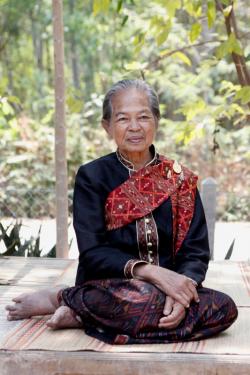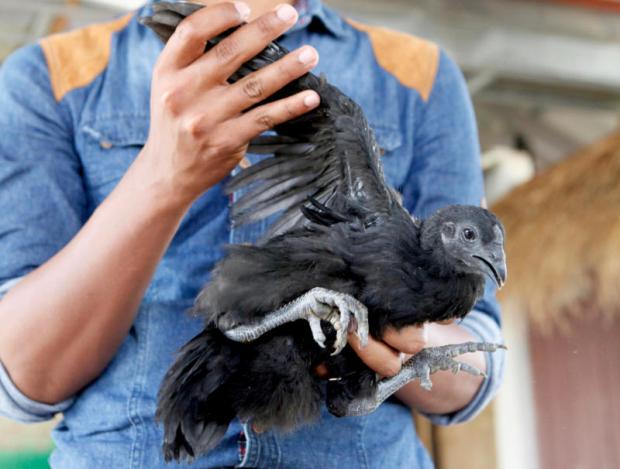They were holding hands while walking, with smiles on their faces. Her Majesty Queen Sirikit and Khammai Yokhasing. Khammai, 84, still remembers the moment when the Queen held her hand at Klai Kangwon Palace in Hua Hin, 40 years ago.
"It was a sudden shock when the Queen turned back and grabbed my hand. I didn't know what to do. I was grinning from ear to ear because I was overwhelmed with happiness," she said, adding that she later saw from the picture that Her Majesty was also smiling.
In 1977, Khammai was the principal teacher in Ban Phon village in Kalasin. The community is home to the Phu Thai ethnic group, who migrated from Laos to Thailand during the early Rattanakosin period. They were farmers who specialised in cloth weaving.
When the villagers learned that Their Majesties, the late King Bhumibol Adulyadej and HM Queen Sirikit, were visiting their village on Nov 29, 1977, they were excited. Khammai had always wanted to see the royal family. She proposed that she and her neighbours wear their traditional Phu Thai dress for the occasion. She wanted to offer nine mon khid (a traditional northeastern pillow) to the Queen.
The Phu Thai dress is outstanding due to a red silk-woven cloth known as phraewa. The textile has a unique character as each woven pattern looks like embroidery. The villagers donned a long-sleeved, front buttoned blouse in black and wore phraewa as a sabai from their left shoulder to the right chest, to greet the royal couple.
After the Queen received their gifts, she was interested in their phraewa.
"The Queen said our cloth was beautiful and asked if she could have one and if we would weave another for her," she recalled.
Days later, the late Thanphuying Suprapada Kasemsant, the Queen's private secretary, visited the village and gave 6kg of silk yarn to Khammai after she was appointed by Thanphuying Suprapada as group leader of phraewa weaving for the Queen.
A year later, her group produced 12 pieces of phraewa and presented them to the Queen at Klai Kangwon Palace.
PRESERVING PHRAEWA

Khammai Yokhasing is known as phra sahai, because she is a friend of Queen Sirikit. Karnjana Karnjanatawe
During their visit to the royal palace in Hua Hin, the weaving group of Ban Phon was a member of the Foundation For The Promotion Of Supplementary Occupations And Related Techniques Of Her Majesty Queen Sirikit Of Thailand, or the Support Foundation.
"Her Majesty told us to keep our heritage alive and to pass on the knowledge to younger generations," said Khamson Srathong, 78, who also visited the palace with Khammai and others. "We were overwhelmed with happiness that the Queen appreciated our traditional cloth."
With the support of the foundation, their phraewa silk has increased in colours and patterns from the original 60 to 100. The people's living conditions have also much improved. They can have extra income apart from working on the land.
"One piece of phraewa is priced from 10,000 to 100,000 baht, depending on the pattern and quality of silk," said Somsri Srathong, head of the Phraewa Silk Cloth Weaving Group of Ban Phon, which has 350 members today.
The silk cloth is well-known nationwide because of the support of the Queen. The phraewa is regarded as the queen of silk clothes.
THE REVIVAL OF MUDMEE SILK
Mudmee silk is tie-dyed silk woven cloth. It has been one of the best-known royal-supported products under the Support Foundation.
Thanks to HM Queen Sirikit, who saw the value of traditional textiles, mudmee is well-known nationwide, according to Wongduean Udomdechawet, 80, president of the Community-Based Enterprise Group Of Craftwork Of Wat That Prasit in Ban Na Wa, Nakhon Phanom.
On Nov 13, 1972, the late King Bhumibol Adulyadej, HM Queen Sirikit and their teenage daughters, Her Royal Highness Princess Maha Chakri Sirindhorn and Her Royal Highness Princess Chulabhorn, visited Wat That Prasit in Ban Na Wa for a kathin (Buddhist robe presentation) ceremony.
Wongduean wanted to offer mudmee, a heritage textile of the Tai Nyo, an ethnic group which also migrated from Laos during the reign of King Rama III. The mudmee had a pineapple pattern in purple and white.
"Her Majesty the Queen told me that the cloth was very beautiful and asked if I wove it myself," recalled Wongduean.
A month later, the late Thanphuying Suprapada asked her and another five people, who also presented their mudmee to the Queen, to produce more cloth. Thanphuying Suprapada offered them an initial fund to weave six pieces of silk. The secretary and her team revisited Ban Na Wa a month after to buy the mudmee. It was the first time the villagers realised the value of their traditional cloth. They were told to weave more traditional patterns for the Queen.
Experts were sent to Ban Na Wa village to teach the villagers the technique of dyeing and weaving to enhance the quality of their textiles. The group has gradually expanded from the original six to 500 members today. At present, they have a learning centre and a shop at Wat That Prasit.
"Our lives have changed for the better since we received support from the Queen," said Wongduean. She still weaves and shares her mudmee weaving skills with the younger generations to keep the cultural heritage alive.
MAKING HANDICRAFTS FOR A BETTER LIVING
Almost 50 years ago when Their Majesties visited villagers in the Northeast where there had been communist insurgent attacks, they also made royal visits to Ban Kut Na Kham in Sakon Nakhon.
Aiming to improve the quality of life of rural people, HM Queen Sirikit initiated the Ban Kut Na Kham Arts & Crafts Centre in 1983, set up on 50 rai of donated land.
According to Lt Prathip Phusritan, the centre started operations by teaching locals to make ceramics. Popular designs being portraits of the King Bhumibol, Queen Sirikit and also traditional Thai characters. The works have expanded to cover eight types of handicrafts, including silk-weaving, making artificial flowers, clay sculptures and woodcrafts. The centre employs 130 people and another 140 weave silk clothes, especially mudmee textiles.
The royal projects of Queen Sirikit have helped countless families in the Northeast escape poverty. The projects have been carried on for almost half-a-century and so do the cultural heritages of the ethnic groups in Isan.

National Artist Khamson Srathong shows pha saew, which is a prototype of a few original patterns of phraewa. Every family in Phu Thai in Ban Phon has their own pha saew, which is a family heritage. Phraewa silk cloth is a 5-star One Tambon One Product from Kalasin and also earned the 'Geographical Indication' status of Kalasin in 2007. Karnjana Karnjanatawe

Ceramics are one of the popular products of Ban Kut Na Kham Arts & Crafts Centre in Sakhon Nakhon. The centre buys high grade clay from Lampang and Chiang Mai to produce large vases and pots. For small ceramic cups and dolls, craftsmen use red clay found in Kut Na Kham. Workshops can be arranged for those who want to try spinning the potter's wheel. Karnjana Karnjanatawe

The art of making khon dresses is also taught at the arts and crafts centre. The first team of 30 people were intensively trained at the Thonburi Art School in Bangkok and will pass on their knowledge to eager students. Karnjana Karnjanatawe

A woman embroiders cloth at Ban Kut Na Kham Arts & Crafts Centre. When finished, the embroidered cloth will look like a painting. Karnjana Karnjanatawe

Wongduean Udomdechawet demonstrates mudmee silk-weaving at the Community-Based Enterprise Group Of Craftwork Of Wat That Prasit in Ban Na Wa, Nakhon Phanom to the Thailand Research Fund team, whose aim is to help promote royal projects in the Northeast. The mudmee group in Ban Na Wa was the first member of the silk-weaving group that was supported by Queen Sirikit. Mudmee is made by using a technique in which warp threads are tie-dyed to create patterns before weaving. Wongduean has won many awards from the Queen for her skills. She's also known as a master of mudmee in the Northeast. Karnjana Karnjanatawe

Woodcraft is another skill provided to locals at Ban Kut Na Kham. The centre offers jobs to anyone regardless of their age or physical abilities. Karnjana Karnjanatawe

Dr Wisut Auekingpetch is a senior veterinarian at the Phu Phan Royal Development Study Centre inside Phu Phan Rajanivet Palace, where Their Majesties King Bhumibol and Queen Sirikit stayed when they visited the Northeast. The palace covers 2,300 rai and is open to visitors. According to Dr Wisut, highlights are black chickens, black pigs, black oxen (a crossbreed of local cattle and the high-quality black cattle from Japan that produces wagyu) and black rabbits. There is a tourist shuttle service with a Thai-speaking guide for group visitors. Karnjana Karnjanatawe
















